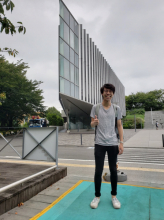
University:
Major:
Site Abroad:
Mentor(s):
Faculty Sponsor(s):
Faculty Sponsor's Department:
Project Title:
Project Description:
Parallel robots are commonly utilized within production lines to perform quick movements. Their light and flexible linkage systems allow shorter travel time and reduced energy consumption at the cost of residual vibrations at the end-effector. Previous research yielded an analytical MATLAB model of the five-link parallel system that found that out-of-plane vibration was the most dominant, and proposed a new PTP control trajectory method that could minimize access time and residual vibrations. To test the trajectories, we worked with Professor Daisuke Matsuura to develop a Visual Studio program that could rotate the two motors, take in reference trajectories, and save the angle encoder log to confirm that the actual trajectory represented the reference trajectory. An accelerometer was attached to the end-effector, and measured resulting vibrations from the reference trajectory and at chosen positions within the workspace. A Fast-Fourier Transform of the results showed that the natural frequency changed depending on the position and configuration of the links, and that the out-of-plane natural frequency primarily stayed around the 5 Hz range. A new PTP control trajectory were generated using the new natural frequency found through the results. Analysis of these new results found that the trajectories greatly reduced the in-plane vibration, and slightly reduced the out-of-plane vibration. However, the angle encoder logs indicated that the motor angular velocities overshot the input reference velocities. Although a control system for the motors will need to be implemented, our results confirmed that the new method for generating a reference trajectory for the parallel robot is effective in damping residual vibrations, and will enable parallel robots in the three-dimensional workspace to utilize the same method.
